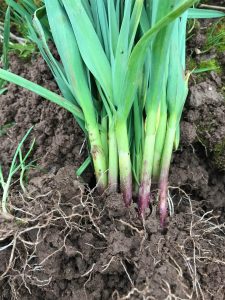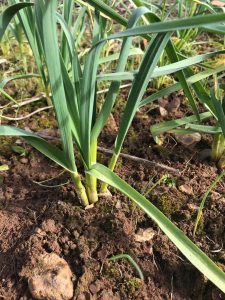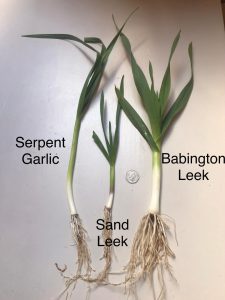Your wheelbarrow is currently empty!
Fire Cider is a traditional herbal remedy used to help with immune support, digestion and warming you from the inside out! It is generally taken by the tablespoon (diluted if necessary) to help ward off cold and flu symptoms through the dark and cold season. It can also be added to winter soups or salad dressings for an extra kick!
Ingredients
-
1 medium onion, chopped
-
1/2 Head of garlic, chopped
-
2 chilli peppers, chopped
-
1/2 cup fresh grated organic ginger root
-
1/2 cup fresh horseradish, chopped or grated
-
Sprig of Rosemary
-
Sprig of Thyme
-
Pinch of Cayenne powder
-
Apple Cider Vinegar
-
Local honey/Maple Syrup or sweetener of choice, to taste after steeping
Optional extra ideas:
-
Lemon, sliced
-
Turmeric fresh or powdered
-
Peppercorns
-
Whatever you fancy!
Method
Add all plant ingredients to an airtight 1 litre jar and add Apple Cider Vinegar until it covers all ingredients and reaches the top of the jar.
Place a piece of parchment paper beneath the jar lid to stop the vinegar touching any metal (or use a plastic lid).
Store out of direct sunlight in a cool place for 4-6 weeks, shaking daily.
Strain liquid contents into another clean jar – add sweetener to taste.
Can be stored in fridge happily for a few months.
There are several varieties of perennial allium – each flowering from July – August, if not harvested – then forming a head of small bulbils that will fall onto the soil to send up yet more plants next year. The following examples are all very low maintenance, hardy and very tasty! Probably the most known about and sought after is the Babington Leek. However, there are other worthy examples, two of which I’d like to take a closer look at here.
 First off we have the Sand Leek – Allium scorodoprasum (Not to be confused with Allium sativum v. ophioscoroson – the Serpent Garlic – both of which also go by the name Rocombole). Sand Leek produces edible stems that can be cut at ground level to then regrow and clusters of bulbils (above ground on looping stems) which can both be used as a mild garlic substitute. Young leaves can also be cut and used as chives. What first struck me about this plant was how quickly it seemed to ‘clump up’ compared to either the Babington or Serpent Garlic. These examples may be slightly smaller than their counterparts but what they lose in size, they certainly make up for in quantity.
First off we have the Sand Leek – Allium scorodoprasum (Not to be confused with Allium sativum v. ophioscoroson – the Serpent Garlic – both of which also go by the name Rocombole). Sand Leek produces edible stems that can be cut at ground level to then regrow and clusters of bulbils (above ground on looping stems) which can both be used as a mild garlic substitute. Young leaves can also be cut and used as chives. What first struck me about this plant was how quickly it seemed to ‘clump up’ compared to either the Babington or Serpent Garlic. These examples may be slightly smaller than their counterparts but what they lose in size, they certainly make up for in quantity.
Taste test: Raw – Leaves: mildly, pleasantly garlicky – Stem: very garlicky! Cooked – Mild, pleasant garlic flavour
Conclusion: Prolific clumping, nice sized stems, very nice flavour and good sized, plentiful bulbils

Next up we have Serpent Garlic (Allium sativum v. ophioscoroson). It produces attractive looping stems with heads of bulbils in summer that will eventually drop and produce new plants. Plants will clump up more each year but slower than Sand Leek. Serpent Garlic will eventually produce an underground bulb up to 6cm diameter but it is recommended to let the plant grow on for a couple of seasons in order to achieve this. Edibility – Bulb can be dug up and eaten raw or cooked. Bulbils – raw or cooked – they have a strong garlic flavour, though they are a total faff to peel. Leaves – raw or cooked. Chopped and used in salads, they are milder than the bulbs. Young stems – recommend cooked.
Taste test: Raw – Leaves: mildly garlicky – Stem: very strong garlic Cooked – Leaves: very mild garlic – Stem: very sweet excellent garlic flavour
Conclusion: A slow grower if you are wanting bulbs and bulbils are fiddly but an excellent tasting stem and clumps up nicely.

Babington Leek (Allium ampeloprasum) Also sends up flowering heads in summer that ripen to heads of nice sized bulbils. All parts of this versatile plant are edible. Although it is best to leave for first season to allow them to bulk up. Harvesting time is usually around March to June. The whole leek can be cut off above the bulb which will regrow. Best to do this before they send up flowering stalk. Leaves can be harvested and have a garlicky flavour. Great in soups, cooked foods, salads, you can also pickle the bulbils. Over the years, as the leeks clump up, they can be thinned and replanted (or eaten!)
Taste test: Raw – Leaves: Oniony not unpleasant – Stem: Strong onion flavour Cooked – Leaves: mild onion – Stem: Excellent mild, creamy sweet onion flavour
Conclusion: Very good sized stems, excellent cooked flavour, plentiful good sized bulbils.
As we celebrate the ushering in of the light, the death and rebirth of the Sun and the promise of longer, warmer days, there are many ways in which we can honour the season with plants.
Evergreens are traditionally used for building wreaths – Pine, Cedar, Juniper and others symbolise protection, prosperity healing and the earth’s natural cycle. Often placed on a door to protect the home.
Holly – Symbolising protection and good luck – and Ivy associated with fidelity and loyalty and representing the bonds of family and friendship, are both traditionally used to decorate homes over Yuletide. Holly sprigs were hung in the home to ensure safety of your family and Ivy to represent the bonds of family and friendship and to remind us of the continuity of life – as Ivy often lives on after its host plant has died. When used together, Holly and Ivy form a union representing the union and faithfulness of couples.
Oak – The mighty oak is traditionally depicted in the tale of the Oak King and the Holly King as defeating his rival at the winter solstice and again ruling over the year until Litha or midsummer when the Holly King takes back the crown – representing the waxing and waning cycles of the year.
Rosemary – A traditional Solstice herb since at least the Middle Ages representing remembrance, loyalty and fertility. It is a restorative herb and a cup of rosemary tea can help restore the body’s inner warmth and fiery determination.
Birch – often the first tree to grow back after fire – representing renewal, rebirth and new beginnings. It is the first month of the Celtic tree calendar after the winter solstice.
However you celebrate this time of year, seasons greetings and well wishes from us at Quercus Edibles
As we plummet swiftly into the ‘Hungry Gap’- the period of time usually between April and June when the last of the winter crops are dwindling and the summer crops are yet to bear fruit- I wonder why we don’t grow more perennial vegetables. Don’t get me wrong- annual veg is great too and I am up there with the first to lay out all my seed packets in January and wait impatiently for the first moment to get sowing, but what about now? This awkward interim? Today I picked Taunton Deane perennial kale, Tree and Welsh onions and Caucasian Spinach- all there ready to harvest, and have been for some time. I nibbled Sweet Cicely, Pink Purslane, Mallow leaves and Sorrel. The perennial garden is alive! This is their time! Imagine if everyone had one or two perennial vegetables in their garden- as well as the usual suspects of rhubarb and asparagus- how much more abundant our plots would be! What perennial veg are you growing? What are some of your faves?
Ladybirds are one of the most recognisable of our garden insects, but also one of the most beneficial. Both adults and larvae are voracious eaters of aphids – and, in reasonable numbers, are able to clear up infestations in a matter of days!
After emerging from hibernation, ladybirds are ready to mate. Batches of about 50 tiny yellow or orange eggs are then laid in a sheltered position (often on the underside of leaves). Ladybirds tend to lay there eggs close to a source of food so that when the eggs hatch about 10 days later, they have an immediate supply to start devouring! This feeding lasts for a few weeks before the larvae enters the pupae stage, attaching themselves to leaves or even polytunnel hoops! Roughly ten days later the adult ladybird emerges – albeit with a soft, often spotless shell. It will take a short period before their shells become hard and resemble the fully established adult ladybirds we are familiar with.
There are several ways in which we can encourage ladybirds into our gardens and growing spaces. As well as aphids, ladybirds also require a source of pollen for food. Growing plants that they find favourable, such as calendula, nasturtium and thyme could help attract them. In my own experience I have often noticed ladybirds clustering (and pupating) on the leaves of Fat Hen (Chenopodium album). An ‘out-of-the-way’ managed patch of this could be maintained for this purpose.
By placing ‘insect hotels’ around your growing space (Ladybirds are quite happy in a small log with holes drilled in to the side), not only can you offer your ladybird friends shelter through their active months, but also help encourage them to hunker down and hibernate ‘on site’.
